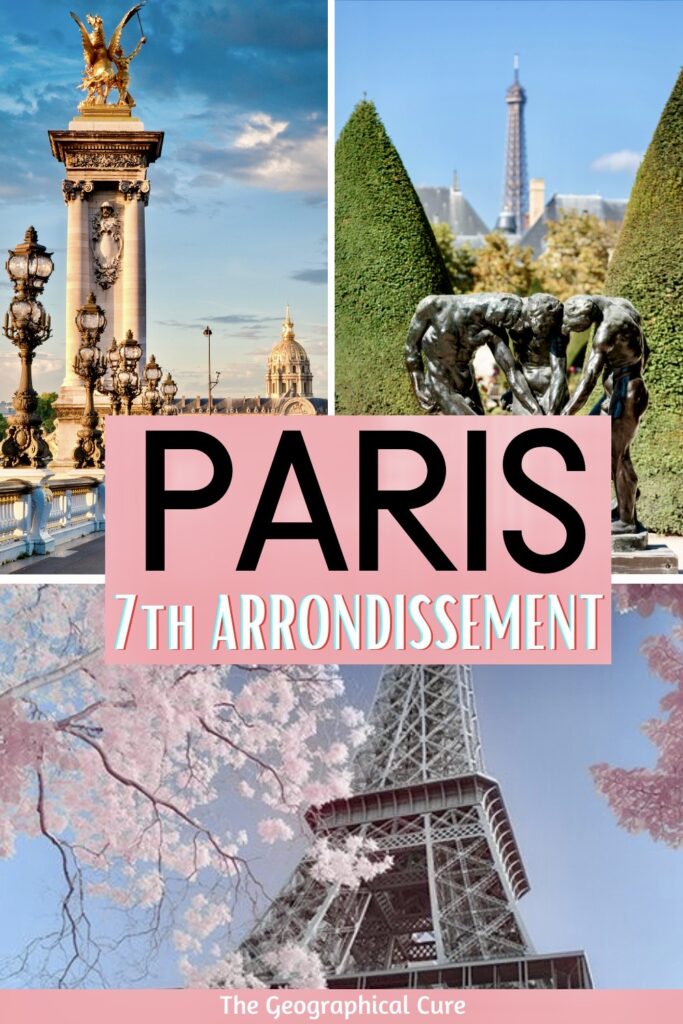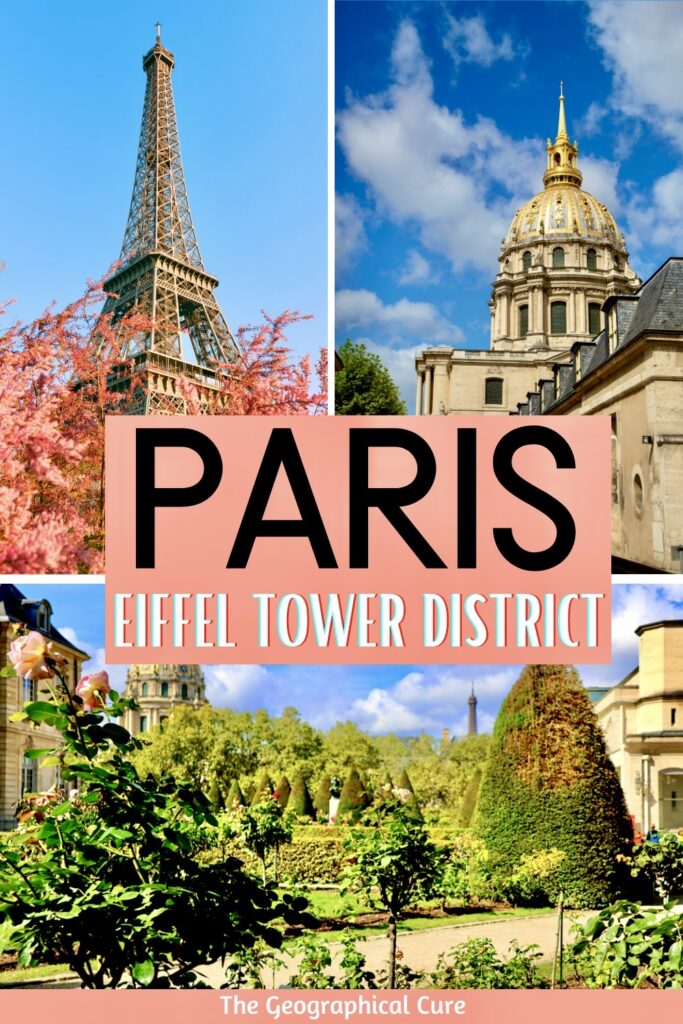The 7th arrondissement of Paris exudes elegance, with its history as a hub for aristocratic mansions and significant monuments. Today, it’s celebrated for its array of museums and the iconic Eiffel Tower, Paris’s most famous tourist attraction.
Originally, the 7th was largely undeveloped land. In the 18th century, however, nobility began returning to Paris and constructed grand mansions. Many of these historic buildings have since been transformed into government offices or museums, including the splendid Hotel Biron and the Palais Bourbon.
Additionally, the 7th arrondissement boasts one of Paris’ premier museums, the Musee d’Orsay, renowned for its impressive collection of Impressionist art. The district is also peppered with smaller, lesser-known museums, each offering its own hidden treasures.
Apart from the monuments, the 7th arrondissement has a human scale, with a renowned market street (Rue Cler) and Art Nouveau architecture along the Avenue Rapp.
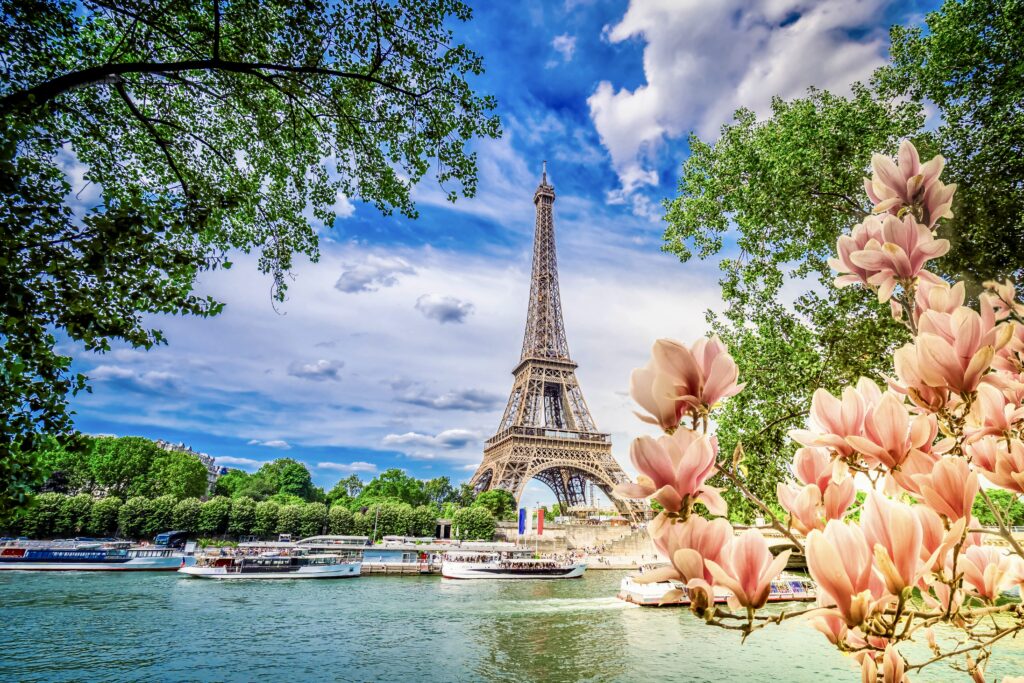
Where Is The 7th Arrondissement?
The 7th arrondissement is located south of the Seine River on the Left Bank. It’s bordered by the Saint-Germain-des-Pres neighborhood to the east and by the 15th arrondissement to the south and west.
Snapshot Of Things To Do in The 7th Arrondissement
- Eiffel Tower
- Champs de Mar
- Musee du Quai Branly
- Rodin Museum
- Pont Alexandre III
- Les Invalides
- Palasi Bourbon
- Musee d’Orsay
- Rue Cler
- Musee Maillol
- UNESCO House
- Avenue Rapp
- Tintoretto’s Last Supper
- Rue de Bac
- Rue St. Dominique
- Le Bon Marche
If you want a pro to show you around this area, you can book a 3 hour guided walking tour.
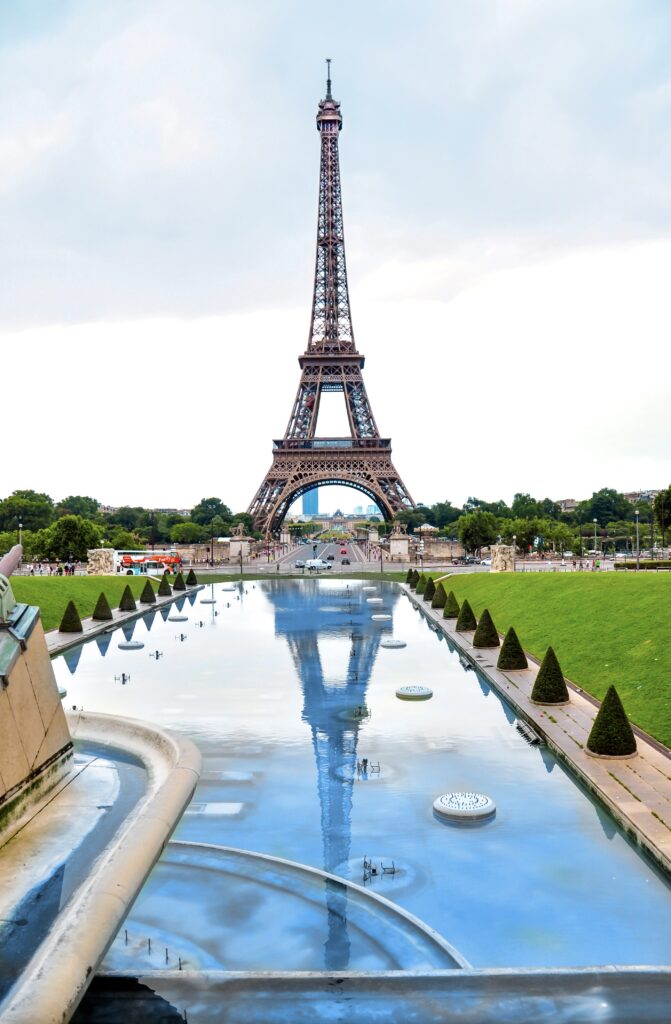
Things To Do In The 7th Arrondissement
1. Eiffel Tower
The Eiffel Tower is one of the most iconic landmarks in France. It’s a lacy iron edifice towering over the Champs de Mar park.
The 1,063 foot Eiffel Tower was built for the World Fair in 1889 in record construction time. It was intended as a statement of France’s technological wizardry.
When it debuted, the Eiffel Tower was the world’s tallest and most innovative building. Predictably, architectural critics and Parisians shunned the new monument.
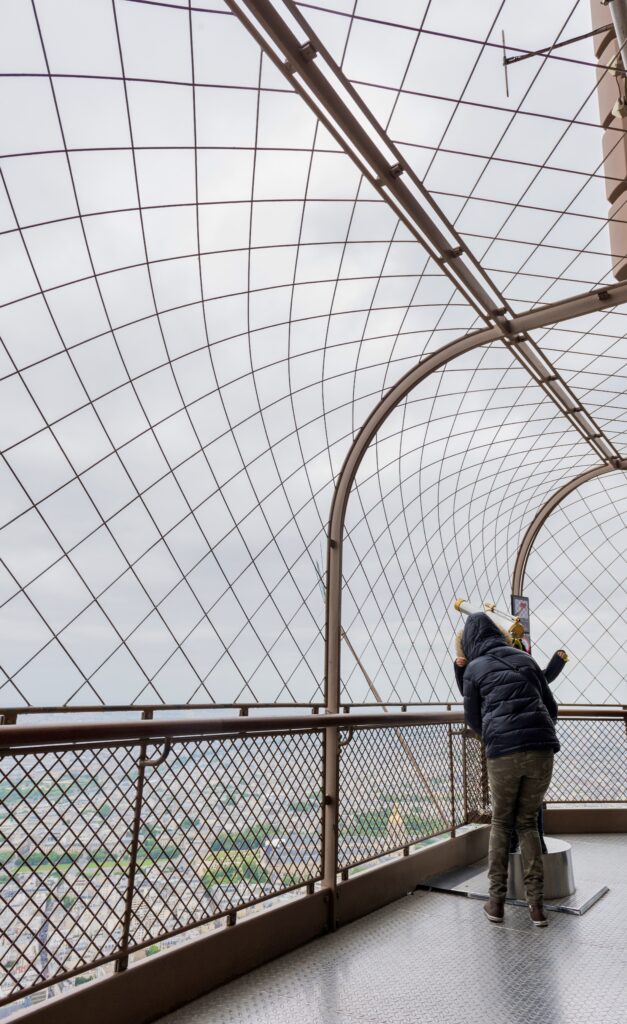
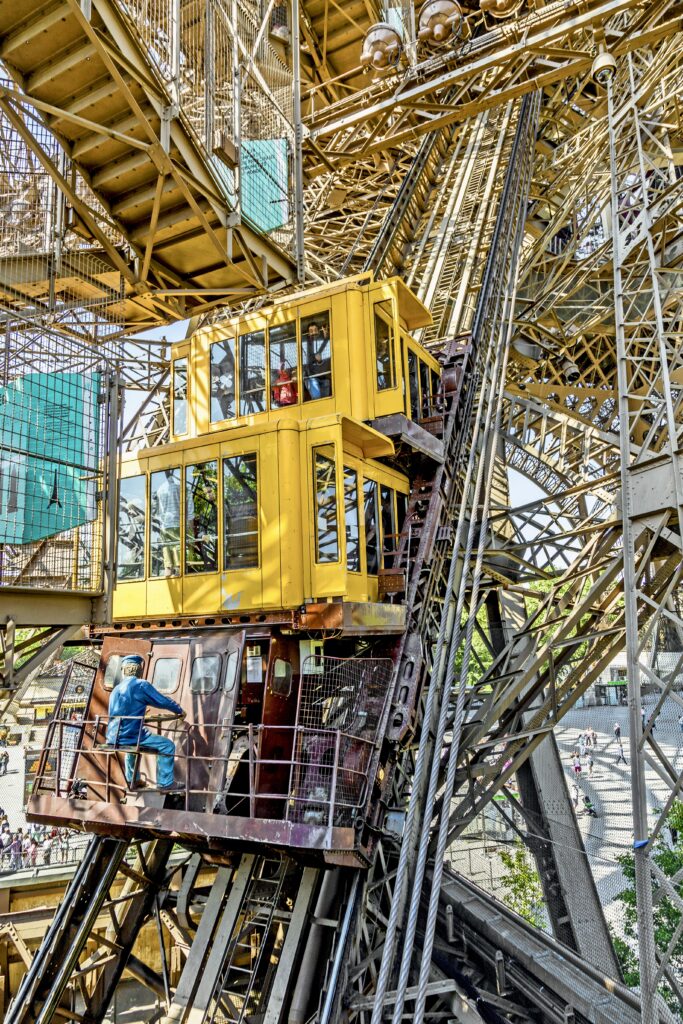
It was dubbed a “hollow candlestick” and a “black smokestack.” Now, it’s a beloved grand dame and the very symbol of Paris.
The tower offers up great views, which extend up to 45 miles on a clear day. There are three levels with observation platforms, at roughly 200, 400, and 900 feet.
They are all connected by elevators and stairs. In 2014, a vertigo-inducing glass floor was added to the first level.
At night, there’s a top-of-the-hour light show when 20,000 lit bulbs sparkle and gleam every 5 minutes on the hour until 11:45 pm.
Ticket prices vary depending on how high you want to go and whether you take the elevator. If you are willing to hike up the stairs instead of taking the lift, you won’t have to wait as long in line.
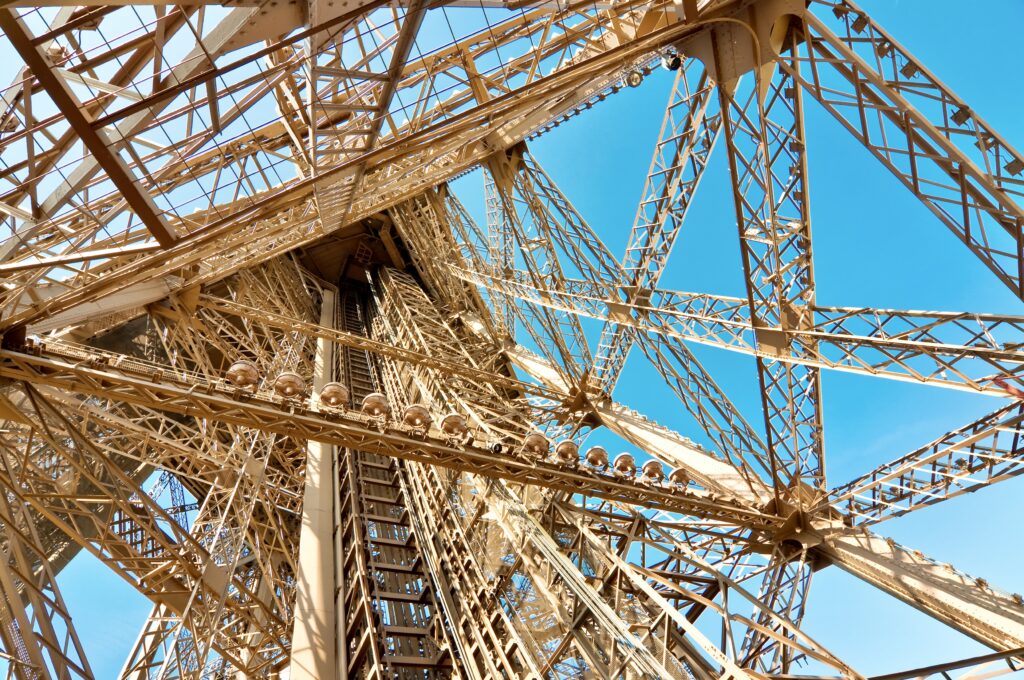
But it’s 704 steps to the second level. You’ll need to be in good physical shape to make that long vertical ascent. From there, pick up a second elevator to the summit.
If you want to dine at the Eiffel Tower, reserve at the Jules Verne restaurant.
The line to visit the tower is never-ending; over 7 million people visit annually. You can wait for hours.
So, it’s absolutely necessary to pre-book a skip the line ticket or tour. Here are some options:
- skip the line ticket with summit access
- guided tour with lift access
- guided tour by elevator
- private 2 hour tour with summit access
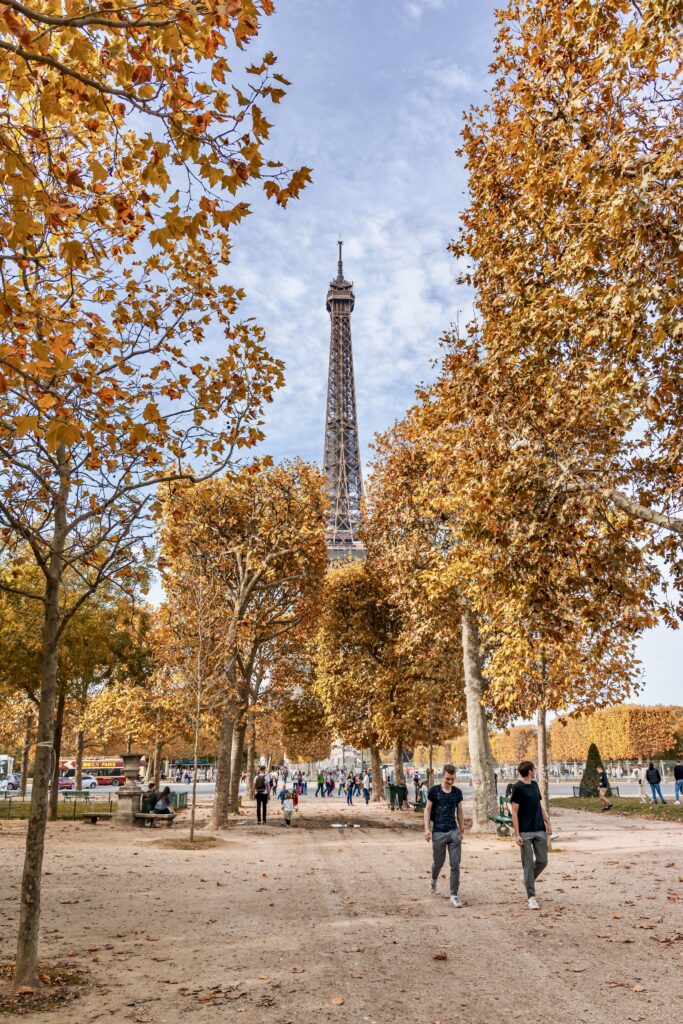
2. Champs de Mars
The park surrounding the Eiffel Tower is the Champs de Mars. It extends from the Ecole Militaire to the Eiffel Tower. It’s named after the Campus Martius in Rome, a tribute to Mars (the Roman god of war).
The park was initially laid out as a parade ground of the Ecole Militaire. This was where France celebrated its first Bastille Day, an occasion where the reigning monarch, Louis XVI, was forced to recognize the new constitution.
Its grassy areas are the perfect spot for picnicking. The park is especially pretty in the spring when magnolias and cherry blossoms are blooming.
The Champs de Mars is also an excellent place to watch the Eiffel Tower lights sparkling at night.
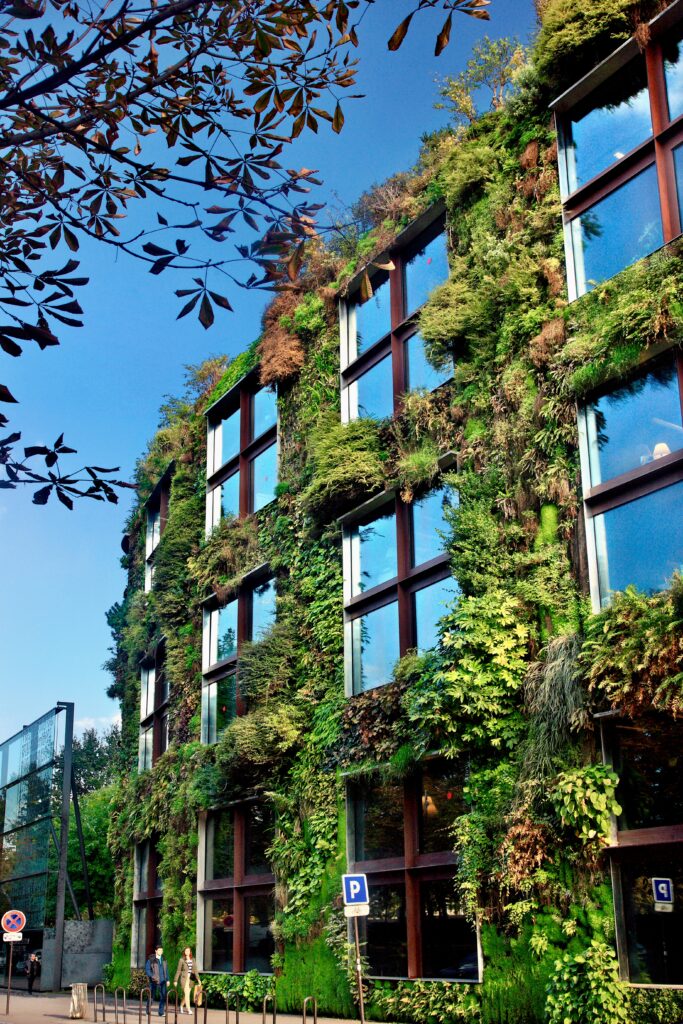
3. Musee du Quai Branly – Chirac
Tired of the usual Paris museums? If you want to a unique thing to do in the 7th arrondissement, head to the Musee du Quai Branly. It’s only one block from the Eiffel Tower.
Opened in 2006, the museum was the brainchild of former President Jacques Chirac. His goal was to elevate non-Western art to the same pinnacle as more traditional Western art.
So, Chirac founded a museum entirely devoted to tribal and non-Western art. It’s housed in an ultra modern building designed by Jean Nouvel.
The museum houses 300,000 works from Africa, Asia, Oceania, and the Americas. The exhibits are shown in a multi-level open floor plan that you can wander at your leisure.
Here’s my complete guide to the Quai Branly. Tickets are 12 euros and you can pre-book one here.
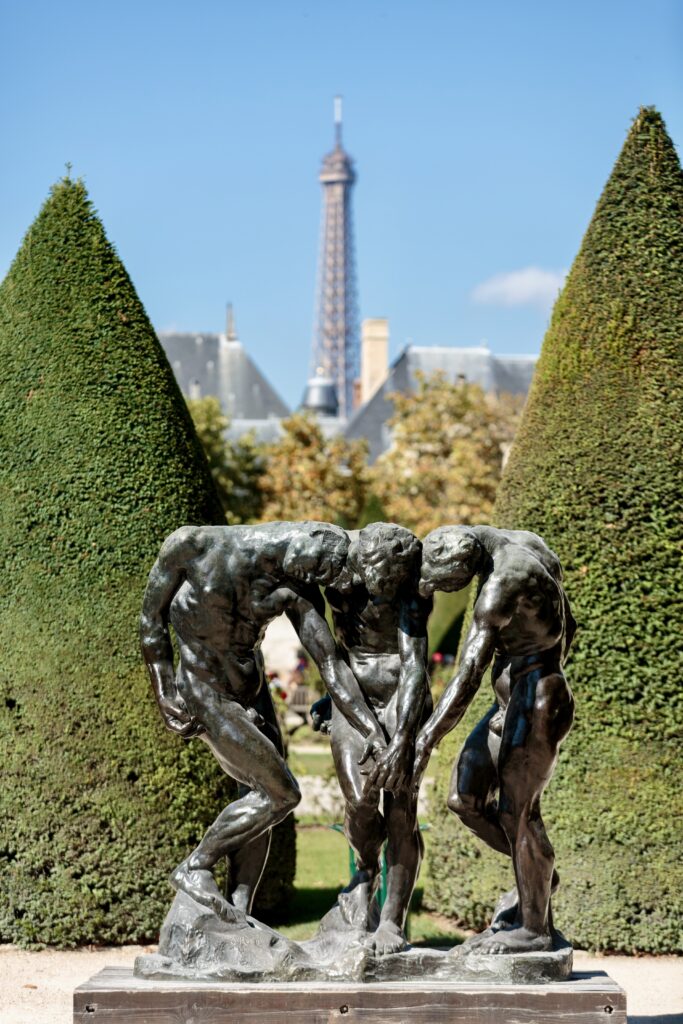
4. Rodin Museum
The Rodin Museum is a spectacular single artist museum dedicated to Auguste Rodin, the father of modern sculpture. It’s one of the most popular and best things to do in the 7th arrondissement.
Rodin toiled away for years in obscurity before finding success, at age 38, with the Age of Bronze. By his mid-40s, he was internationally acclaimed.
The permanent collection consists of over 6,000 art works. It’s housed in Rodin’s former residence, the magnificent 18th century chateau-like Hotel Biron and its exquisite gardens.
There are no less than 27 sculptures set amid the pointy shrubs of the gardens alone. And you’ll have stunning views of the Eiffel Tower and Les Invalides from them.
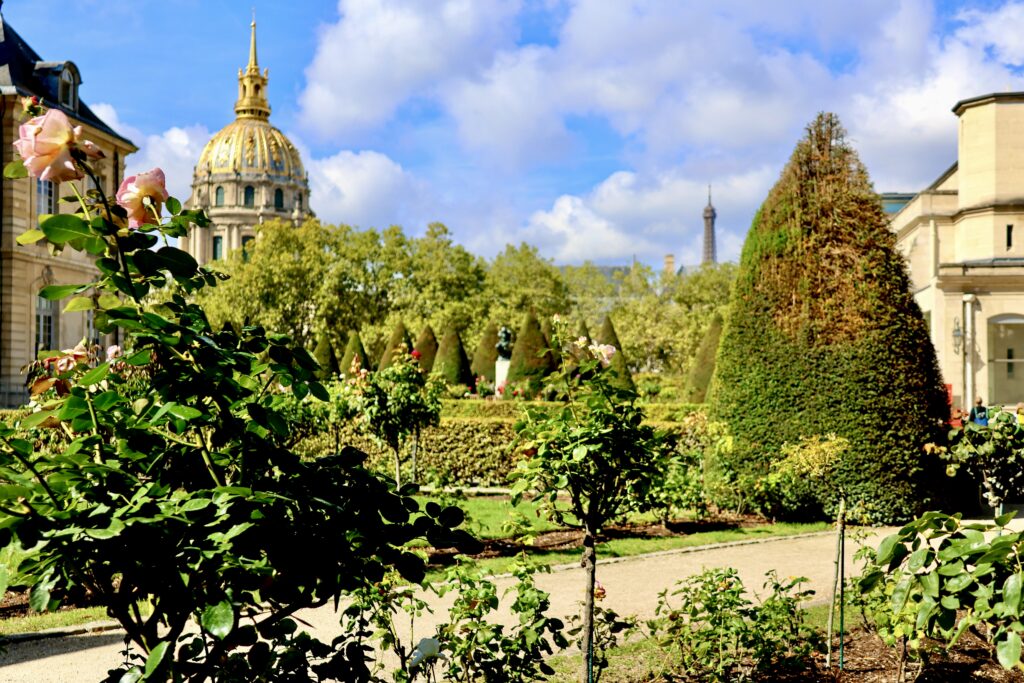
The museum displays works by Rodin, works by his muse-lover Camille Claudel, and some Greco-Roman sculptures. Rodin donated all the sculptures to the French state.
Rodin’s most famous works are here, including The Thinker, The Gates of Hell, The Burghers of Calais, Balzac, and The Kiss.
Here’s my complete guide to the Rodin Museum. Click here to purchase a skip the line ticket.
If you need a coffee or bite to eat, you can stop in at the Rodin Museum cafe, Café L’Augustine. 5 minutes away is one of Paris’ most popular cafes, Cafe Coutume.
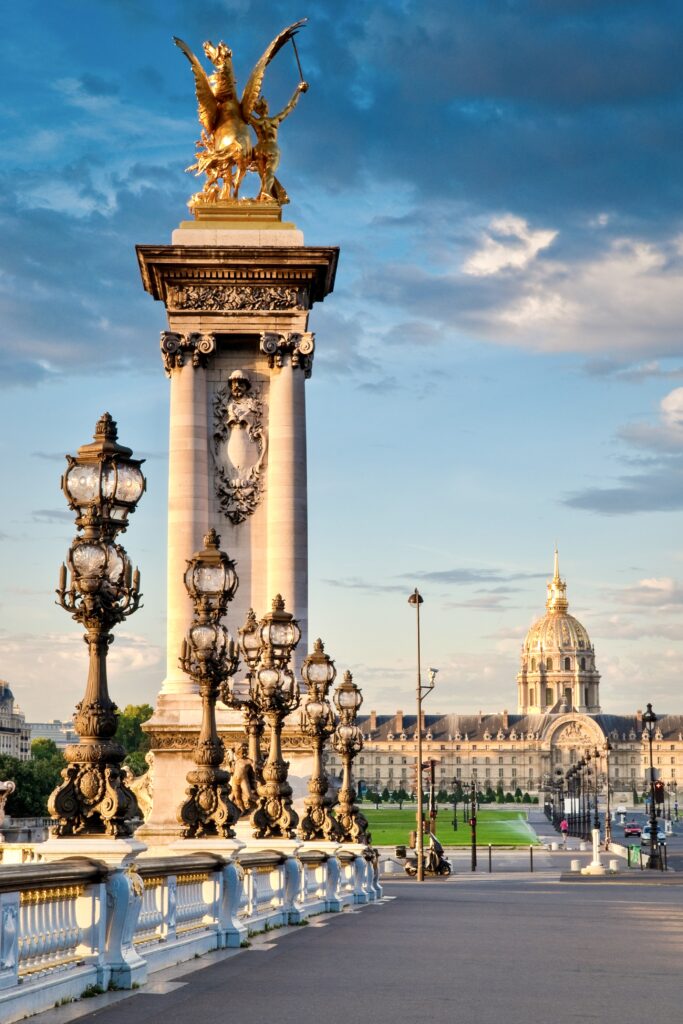
5. Pont Alexandre III Bridge
The Pont Alexandre III is the most beautiful and elegant of Paris’ 37 bridges. 23 of the bridges are part of Paris’ Banks of the Seine UNESCO designation.
Built for the Universal Exposition of 1900, the bridge is a Belle Epoque confection that links Les Invalides to the Champs-Élysées. It was named in honor of Tzar Alexandre III, the son of the last tzar of Russia.
The bridge is decorated with nymphs, garlands, trumpet-blowing angels, birds, cherubs, dolphins, starfish, and sea monsters. It was the first bridge in which electric lighting, in the form of ornate candelabras, was installed.
From the bridge, you’ll have breathtaking views of the Eiffel Tower, the Petit Palais, and the Grand Palais.
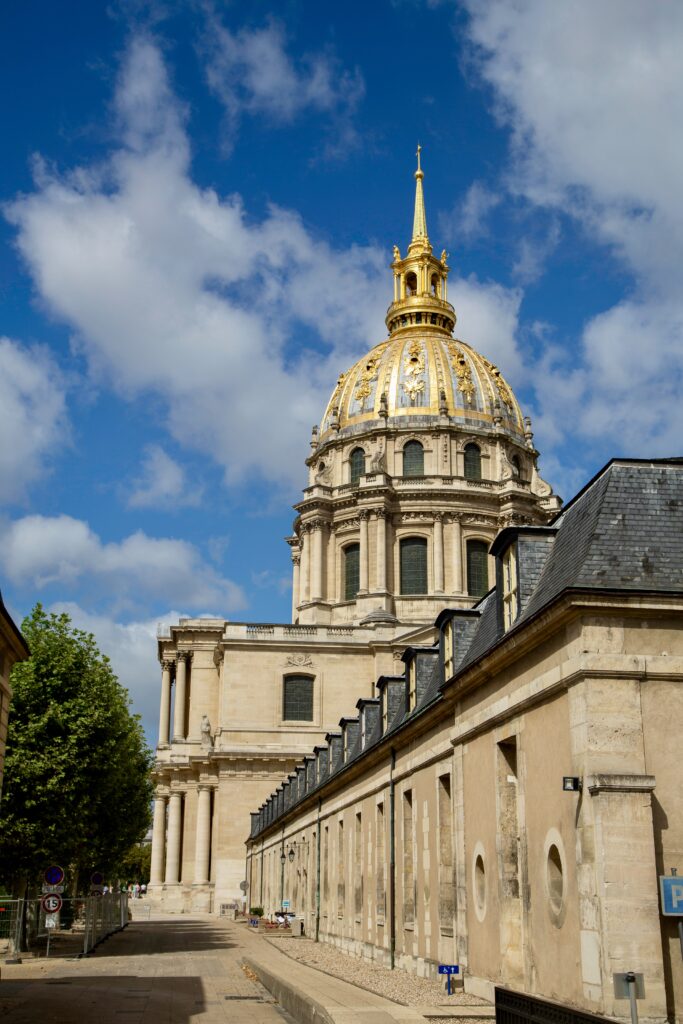
6. Les Invalides
The iconic gold dome of Les Invalides is a gleaming landmark visible from all over Paris. It sits at the end of the glamorous Pont Alexandre III Bridge and is one of the best things to do in the 7th arrondissement.
Louis XIV originally built Les Invalides as a hospital for veterans. After Versailles, it’s the Sun King’s most famous architectural project.
Today, Les Invalides is a complex of military museums and monuments. You can visit the Musee de l’Armee, the Musee des Plans-Reliefs, the Musee de l’order de la Liberations, and the Church of St.-Louis-des-Invalides.
Most famously, Les Invalides is the final resting place of Napoleon I.
Napoleon’s tomb is right under the gold dome of the church, which was designed by Jules Hardouin-Mansart. The church initially was a royal chapel, but became an imperial mausoleum when Napoleon’s ashes were interred there.
If you want to see Napoleon’s real tombstone, check out the left hand side of the church exterior. Now in 3 pieces, the tomb is hidden at the foot of a tree behind a small thicket.
Of the three military museums on site, the Army Museum is the most important, with one of the world’s largest military collections. You’ll find artifacts from antiquity to WWII.
Click here to book a skip the line ticket to Les Invalides.
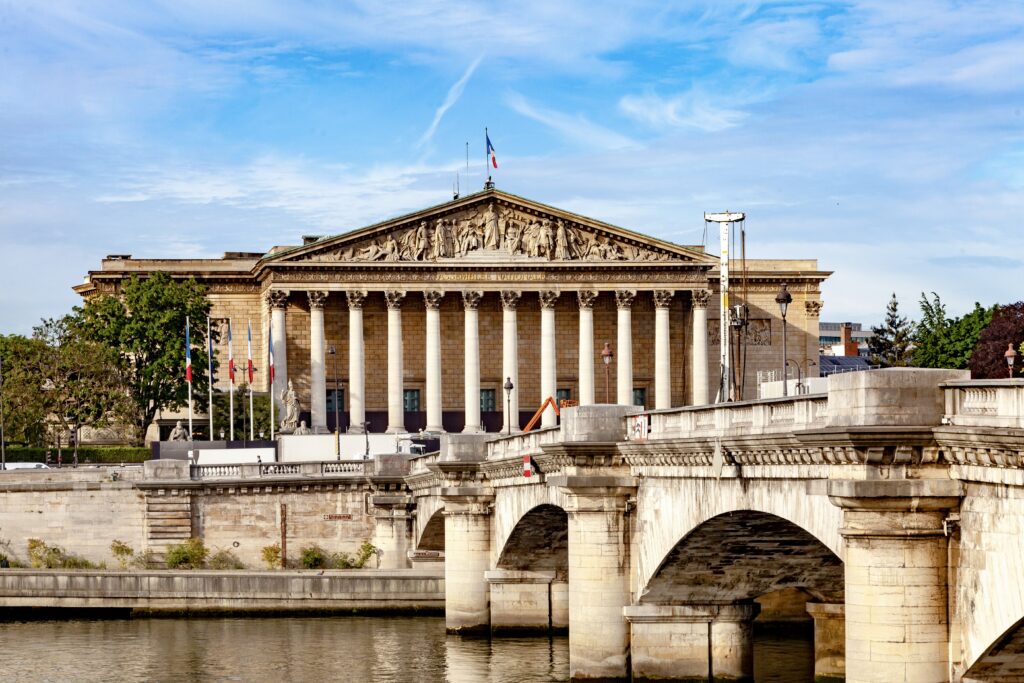
7. Palais Bourbon
When the Sun King Louis XIV died in 1715, the Parisian nobility were delighted to return to Paris from Versailles.
One of the ornate homes they built was the Palais Bourbon, which is now the home of the elected deputies of the National Assembly.
The palace was built between 1722-28 for the Duchess of Bourbon (the legitimized daughter of Louis XIV and Madame de Montespan). The architecture was inspired by ancient temples and the Church of La Madeleine.
In 1795, during the French Revolution, the French government confiscated the building.
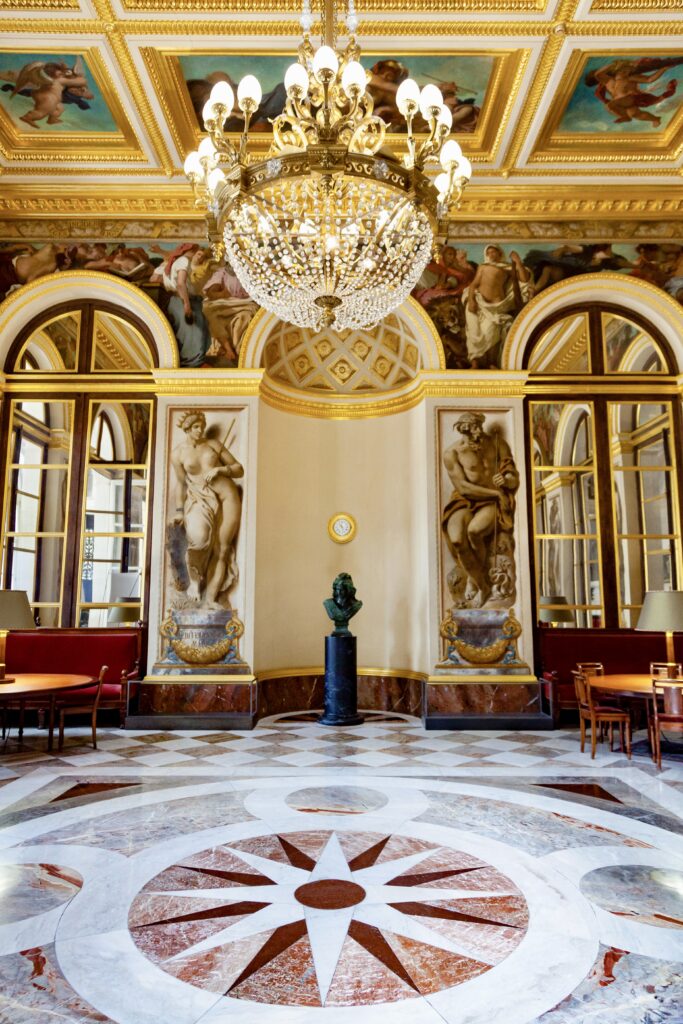
The palace has a magnificent library decorated with frescos depicting the History of Civilization by Romantic era artist Eugene Delacroix.
From the Place de Palais Bourbon, you can see an astonishing contemporary sculpture in the center of the main courtyard.
It’s a black granite sphere created by Walter de Maria. The sculpture stands on a base of white marble and conceals within its core a second (invisible) solid gold sphere.
You can visit the Palais Bourbon on heritage days or make an appointment for a tour.
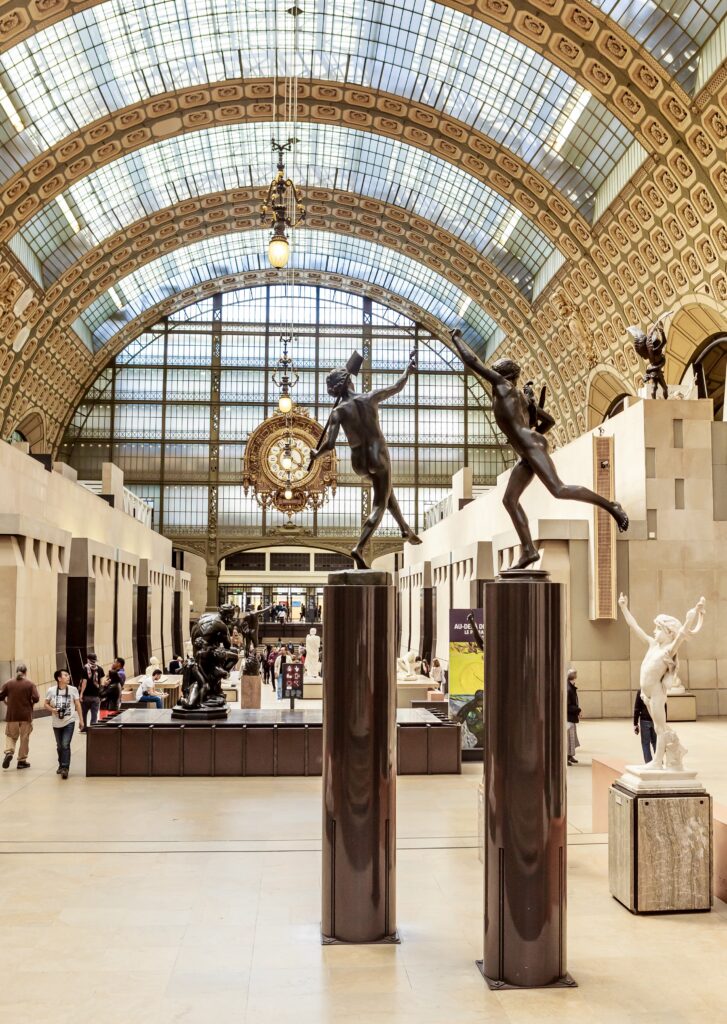
8. Musee d’Orsay
The Musee d’Orsay may be Paris’ most beloved museum. It’s housed in a dramatic 19th century train station.
The museum is famously home to the world’s largest collection of Impressionism and Post-Impressionism art works from artists born after 1820.
This was a hugely important period in art history, where artists rejected academic conventions and adopted a radical new approach to color and composition that would go on to influence Picasso and Matisse.
The Orsay is where you go to see pieces by Van Gogh, Monet, Manet, Cezanne, Seurat, Renoir, and Rodin. The museum also has rich collections of academic art, Realism, decorative arts, and photography.
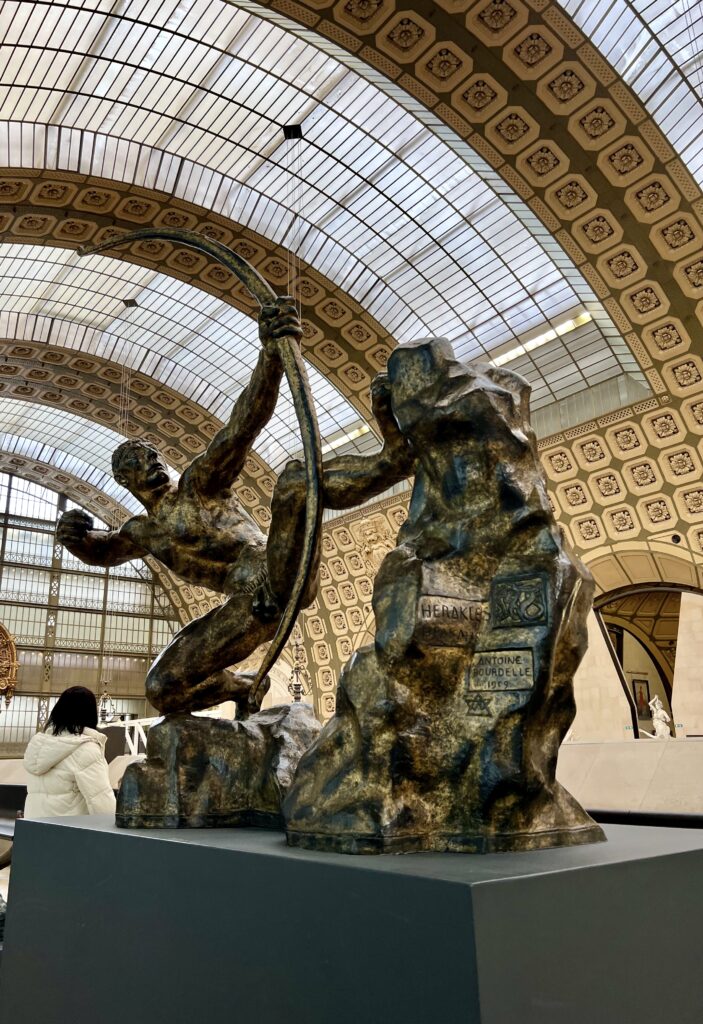
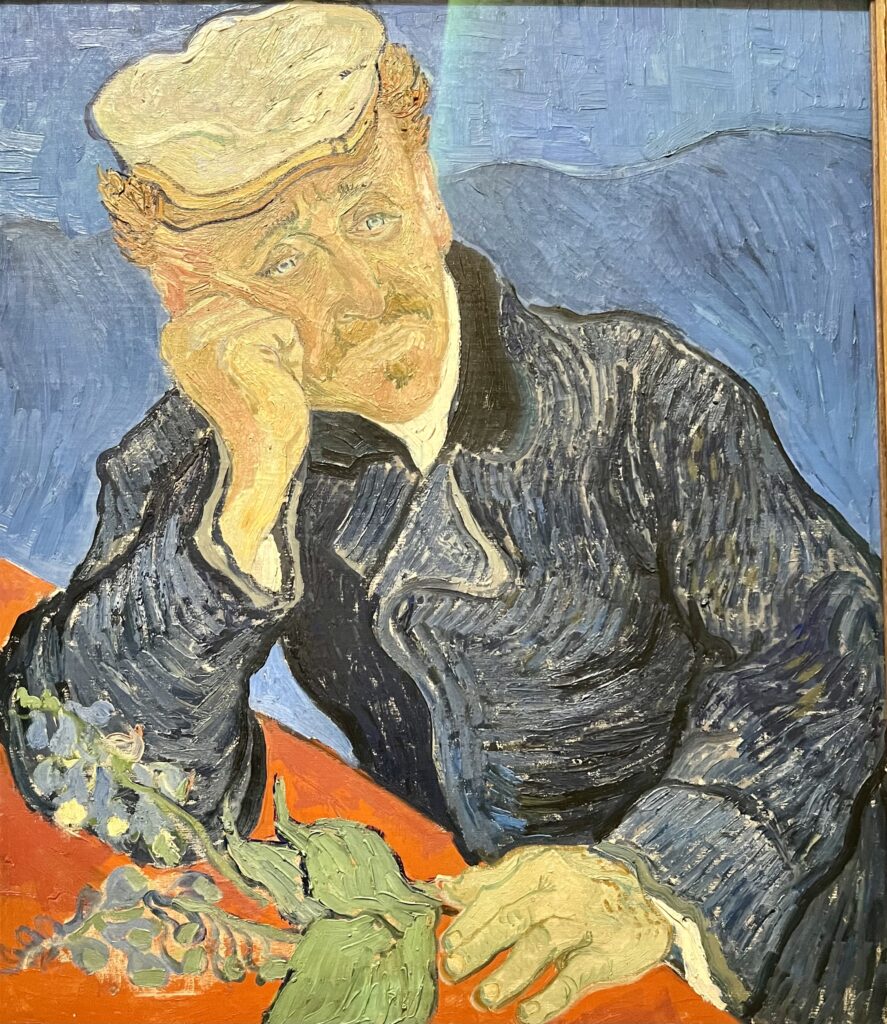
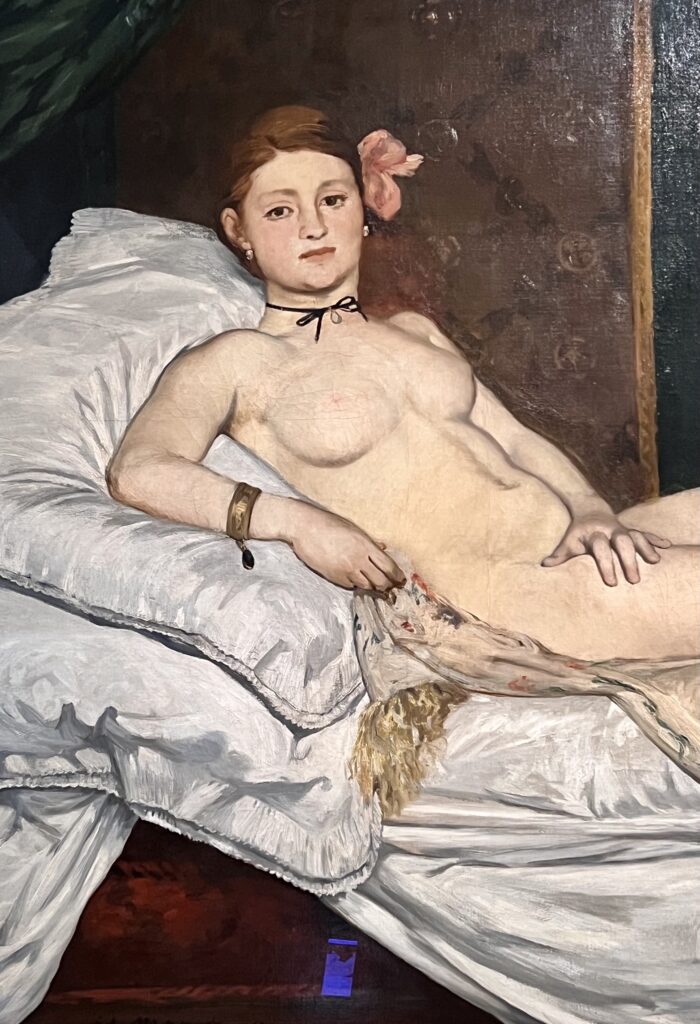
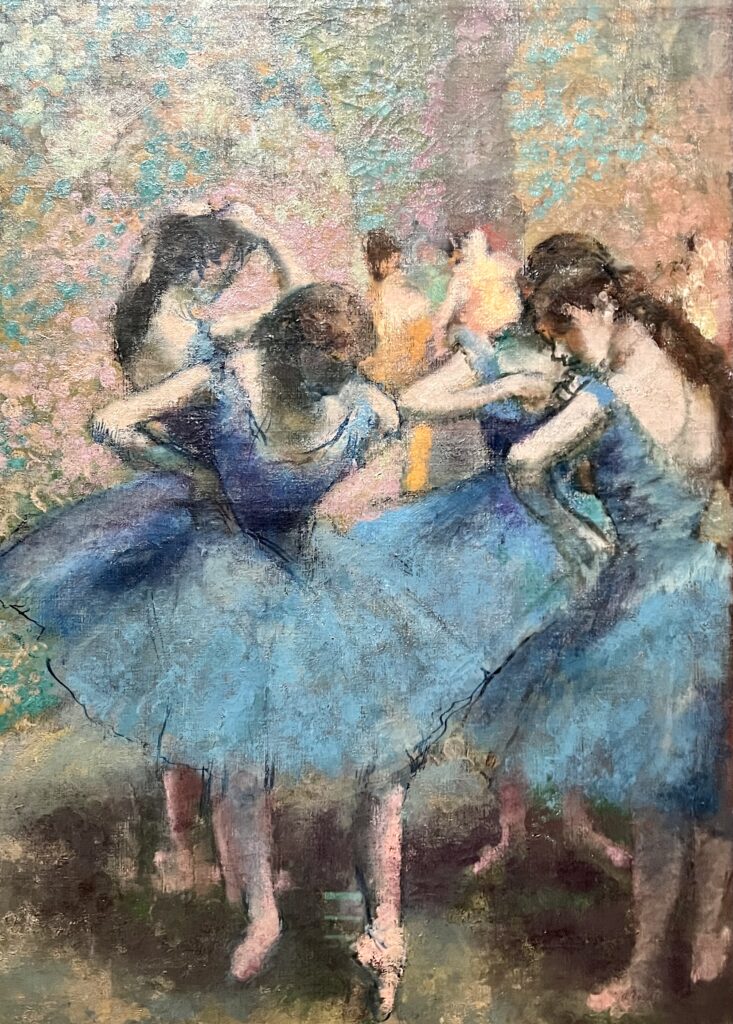
Some of the masterpieces you’ll see include Van Gogh self-portraits, Manet’s Olympia and Dejeuner sur l’Herbe, and Monet’s haystacks, water lilies, and cathedrals.
The central aisle of the museum displays mostly 19th century Neo-Classical sculpture. The most notable piece is Carpeaux’s The Dance, which was once on the facade of the Opera Garnier.
The second floor has a sculpture terrace. One quarter of it is devoted to the works of Rodin. You’ll also find the famous Hercules the Archer by Émile Antoine Bourdelle.
Here’s my complete guide to the masterpieces of the Musee d’Orsay and my must know tips for visiting the Orsay. You can book a skip the line ticket on Get Your Guide or Viator. You may also want to book a guided tour.
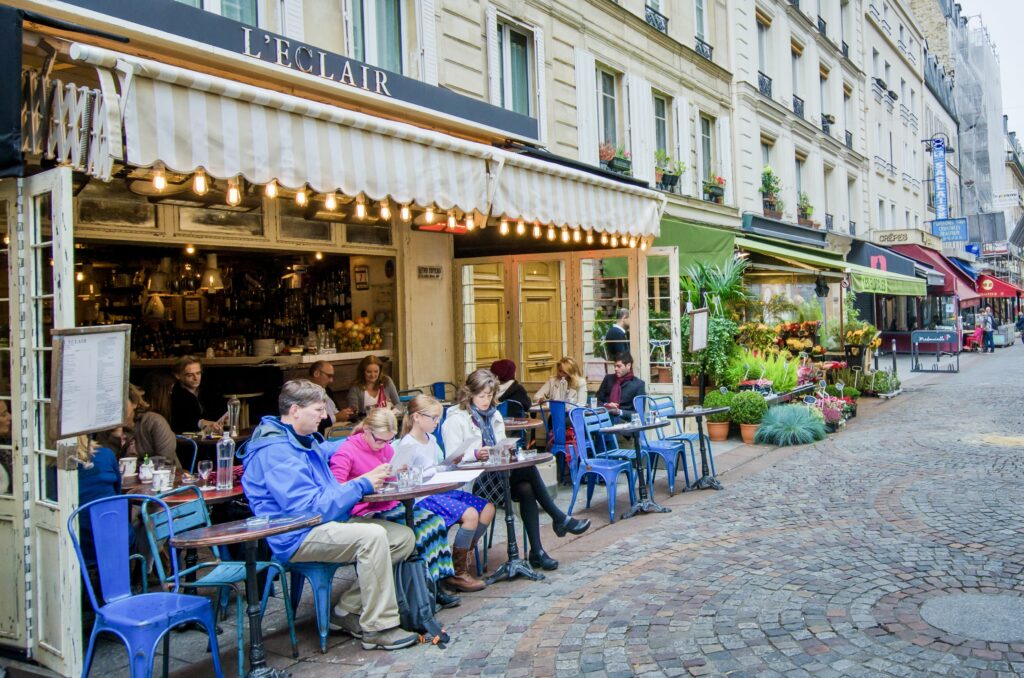
9. Rue Cler
Rue Clear is a lively market street and one of the best things to do in the 7th Arrondissement. Most of the street is pedestrianized with its original cobblestones.
Rue Cler a great spot to buy groceries or pick up supplies for a picnic on the Champs de Mar. You’ll find fresh produce, cheese shops, patisseries, and fancy gelato shops. You can visit Laduree for macaroons.
If you want to sit town and relax, there are many tiny bistros that spill out onto the street. A couple popular spots are L’Eclair (great cocktails), Le Petit Cler, and Cafe du Marché.
10. Musee Maillol
The Maillol Museum is a secret hidden gem and an unusual thing to do in the 7th arrondissement.
It houses a full range of Aristide Maillol’s works and works by his contemporaries Matisse, Dufy, Bonnard, Rodin, and Gauguin. The museum also hosts some blockbuster temporary exhibitions.
Maillol was an early 20th century sculptor who helped shape the course of modernism. The artist’s lifelong obsession was the female nude.
Maillol’s model and muse, Dina Vierny, opened the museum in 1995. It’s interesting to pair a visit here with the Rodin Museum. Maillol’s abstract and classicizing sculptures are in stark contrast to his contemporary’s emotional subjects.
Here’s my complete guide to the Musee Maillol. Tickets are € 14 and € 5 for audio guide. (The museum is not included in the Paris Museum Pass.)
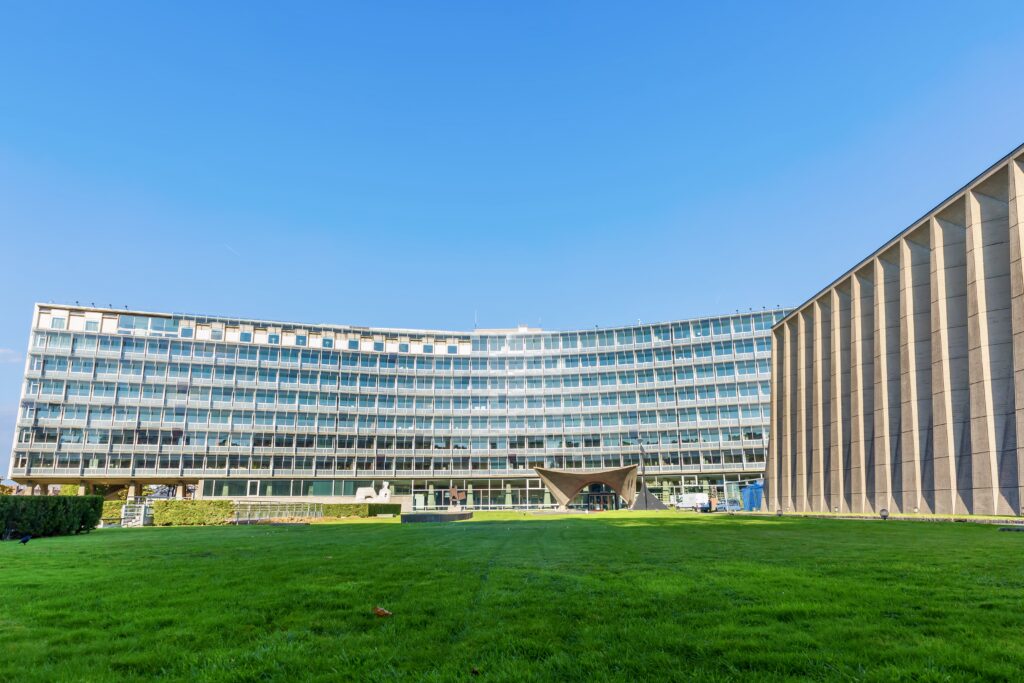
11. UNESCO House
UNESCO House is a secret art museum hiding in plain sight in the 7th arrondissement. It’s a stunning seven floor Modernist building designed by some of the world’s most famous architects, including Le Corbusier and Walter Gropius.
In 1995, Tadao Ando added a unique “meditation space” in the form of an irradiated concrete cylinder with flowing water. Ando’s intent was to create a space where people from all races and religions could pray for peace.
You’ll also find a Zen garden, a panoramic terrace, and 600 works of art by artists like Picasso, Henry Moore, Joan Miro, and Alexander Calder.
In the foyer of the Conference Halls sits Picasso’s largest work, the Fall of Icarus from 1958. Back outside, you can admire the Japanese Garden created by Isamu Noguchi.
Visits can be organized for the general public. Contact unesco@cultival.fr(link sends e-mail) to register for a guided tour. The building also hosts concerts and has an interesting bookstore.
12. 29 Avenue Rapp
At 29 Avenue Rapp, you’ll find what I think is Paris’ most gorgeous door. It’s right near the Eiffel Tower in the 7th arrondissement.
It’s considered an Art Nouveau masterpiece by Jules Lavirotte. The flamboyant door evokes a lush Garden of Eden.
At the top of the door, is a bust of the architect’s wife, Ms. Jules Lavirotte. She’s flanked by Adam and Eve sculptures and sinuous vines, in near ornamental delirium.
Below her is a door adorned with a giant inverted phallus. It has a central glass panel and two oval shaped glass panels. The sexual symbolism was intentional and considered scandalous at the time.
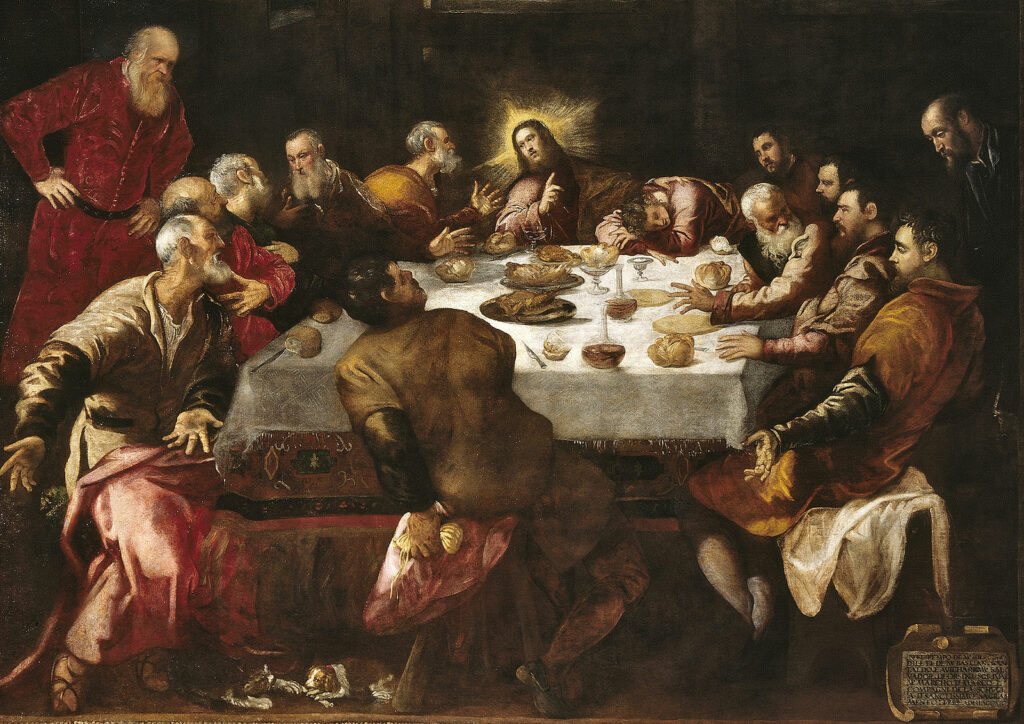
13. Tintoretto’s The Last Supper
Are you a fan of the Venetian Renaissance? If so, one of the best hidden things to do in the 7th arrondissement is a visit to St.-François-Xavier Church.
Don’t be put off by the rather ugly exterior. Inside lies a little known masterpiece by Tintoretto, one of the great masters of the Venetian school.
His painting of The Last Supper is in the “wedding sacristy.” It’s the only Tintoretto to hang in a Paris church.
Christ is in the center with a gold halo. The focus of the painting is which apostle will betray him. Though his back is turned away from the viewer, you can see Judas clutching a purse of silver pieces.
You can only visit the church on Saturday from 9:00 am to noon or make an appointment at www.sfx-paris.fr.
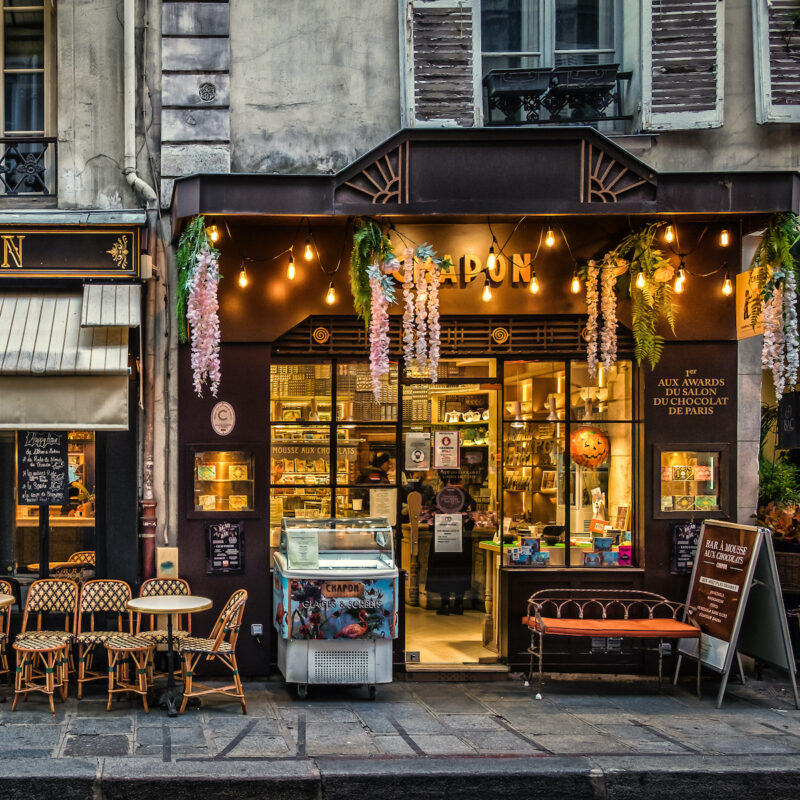
14. Rue du Bac
You can’t go to the 7th arrondissement without a stroll down the iconic Rue du Bac.
It’s a quintessential Paris street and provides a flaneur-type break from all the monuments in the 7th arrondissement. It’s full of chic boutiques, cheesemonger shops, flower shops, and charming cafes.
You can get Paris’ best hot chocolate at Angelina and sample more chocolate goodies at Chapon.
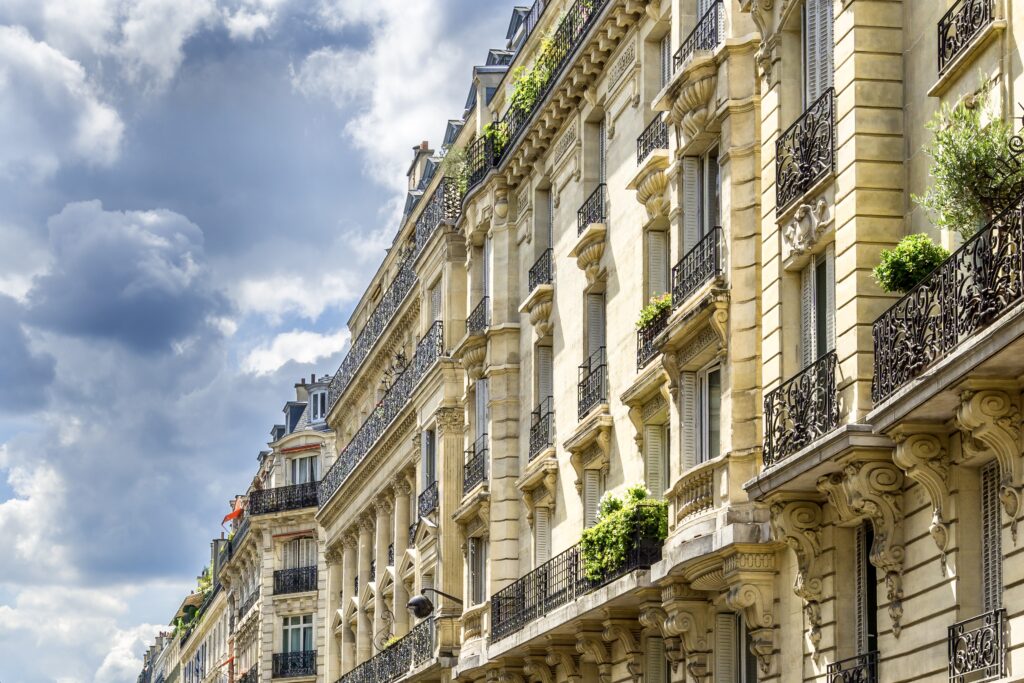
15. Rue St. Dominique
This is another beautiful street in Paris that was once in the village of Grenelle (before it was absorbed into the city of Paris). It’s near the Eiffel Tower, just 15 minutes away.
Like Rue du Bac and Rue Cler, shops, cafes, bakeries, and boutiques line the lively street. If you want to live like a Parisian, this is a great place for one stop shopping.
You’ll also find chic brasseries and hotels. You can also see the Eiffel Tower from the street.
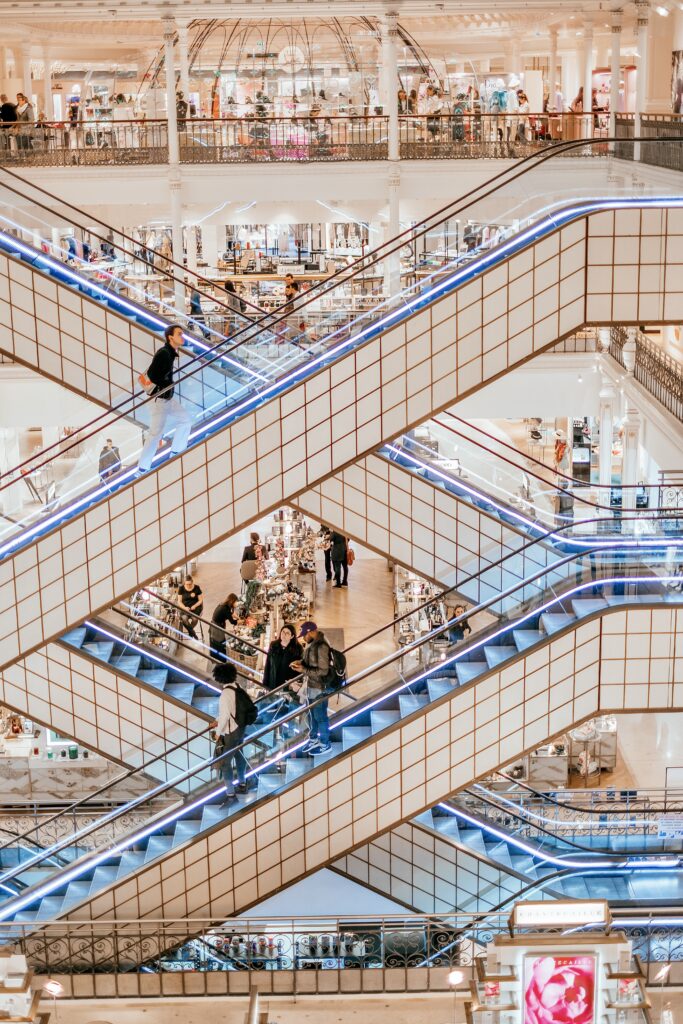
16. Le Bon Marche
Le Bon Marche is on the corner of Rue du Bac and Rue de Sevres. It’s Paris’ oldest department store.
It’s the only Grand Magasin on the Left Bank. The others (Galeries Lafayette, Printemps, La Samaritaine) are on the Right Bank.
Le Bon Marcher was founded in 1852 by a husband and wife duo Aristide and Marguerite Boucicaut.
It was designed by Louis-Charles Boileau and the Gustav Eiffel Company. The multi-purpose store has an open plan and dazzling geometric dazzling escalators.
Le Bon Marche has cool high end luxury brands and the best selection of products from skincare to clothes. Each floor is designed to house different collections in little salons.
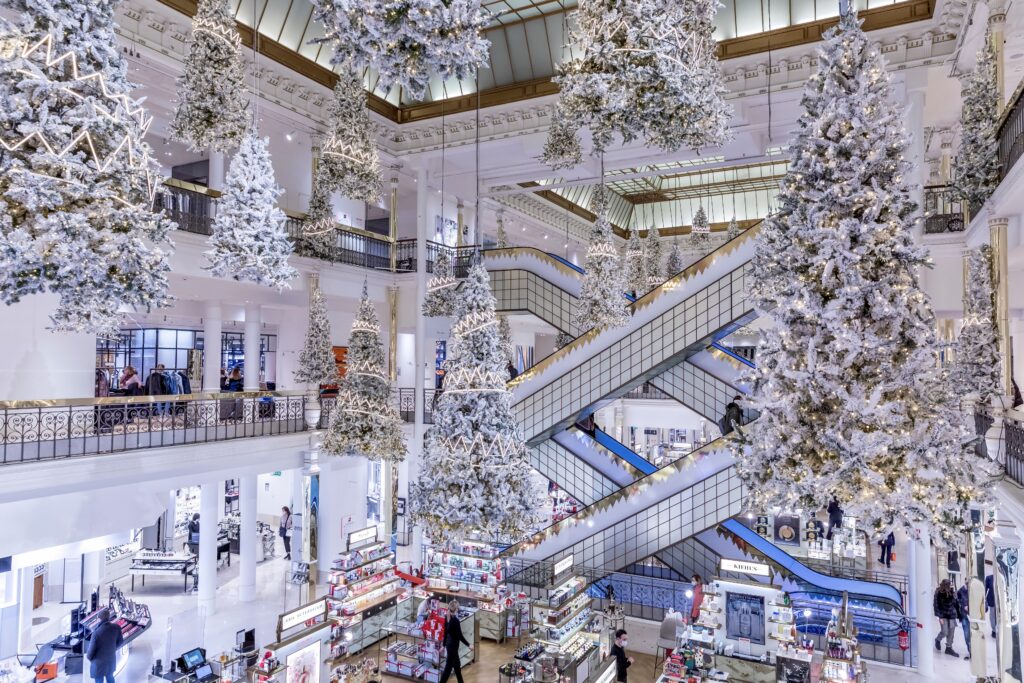
It’s also where the Parisians like to shop, so you’re sure to look stylish after a shopping spree.
Just across the street, La Grand Epicerie is another Le Bon Marche store. It’s a gourmet food emporium with over 30,000 products. Many of them are made on site. The store is a must see for every foodie.
Where To Stay In The 7th Arrondissement
Want to stay in this area? There are loads of options.
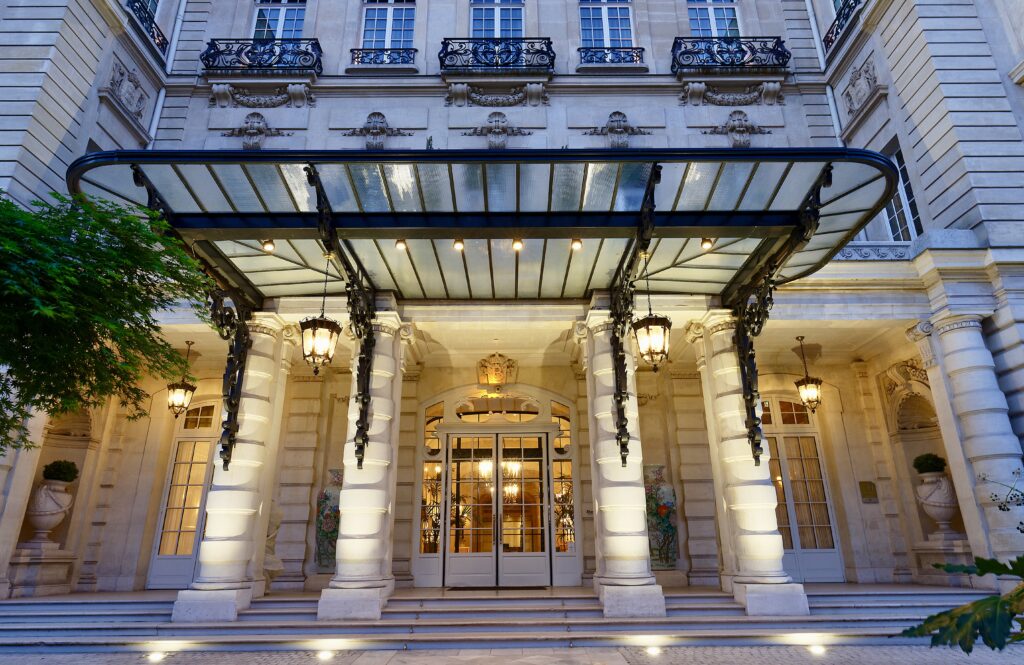
Shangri-La Paris is an extremely elegant luxury hotel in the former palace of Prince Roland Bonaparte. It boasts unmatched views of the Eiffel Tower from its rooms.
You can also check out Le Narcisse Blanc Hotel & Spa (so very chic), Hotel la Comtesse (4 star hotel with a Turkish steam room), or Le Cinq Codet (luxury boutique hotel).
The Pullman Paris Tour Eiffel is a popular four star hotel located right at the foot of the Eiffel Tower. You don’t even have to spring for a suite to get an Eiffel Tower view. Most of the standard rooms have views too.
I hope you’ve enjoyed my guide to best things to do in the 7th arrondissement near the Eiffel Tower. You may enjoy these other Paris travel guides and resources:
- 5 Day Itinerary for Paris
- 3 Day Itinerary for Paris
- 2 Day Itinerary for Paris
- One Day In Paris Itineraries
- Tips for Planning a Trip to Paris
- Tourist Traps To Avoid In Paris
- Top Attractions in Montmartre
- Top Attractions in the Latin Quarter
- Top Attractions in the Marais
- Best Museums In Paris
- Hidden Gems in Paris
- Secret day trips from Paris
Pin it for later.

